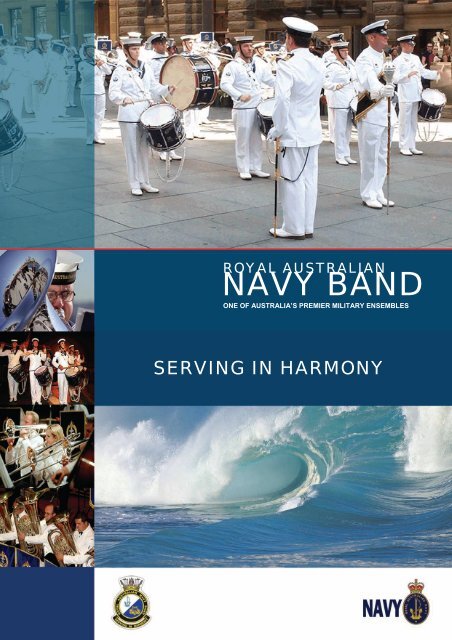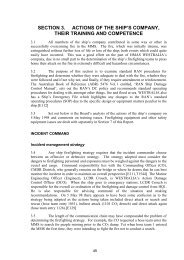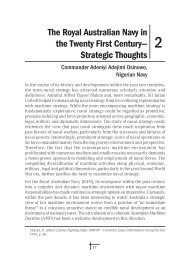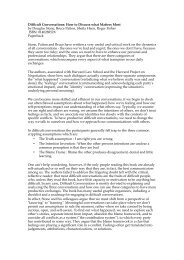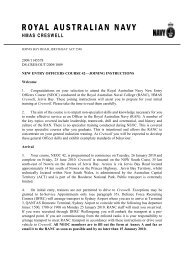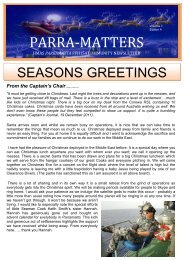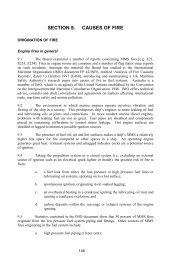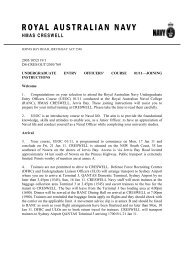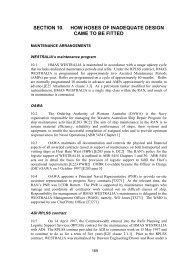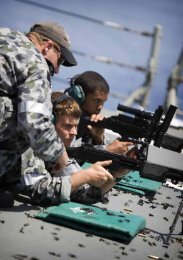NAVY BAND - Royal Australian Navy
NAVY BAND - Royal Australian Navy
NAVY BAND - Royal Australian Navy
Create successful ePaper yourself
Turn your PDF publications into a flip-book with our unique Google optimized e-Paper software.
ROYAL AUSTRALIAN<br />
<strong>NAVY</strong> <strong>BAND</strong><br />
ONE OF AUSTRALIA’S PREMIER MILITARY ENSEMBLES<br />
SERVING IN HARMONY<br />
1
ROYAL AUSTRALIAN <strong>NAVY</strong> <strong>BAND</strong> MIDDLE EAST DEPLOYMENT 2003 / 2004<br />
ROYAL AUSTRALIAN <strong>NAVY</strong> <strong>BAND</strong> MIDDLE EAST DEPLOYMENT 2005 / 2006<br />
ROYAL AUSTRALIAN <strong>NAVY</strong> <strong>BAND</strong> MIDDLE EAST DEPLOYMENT 2008
CONTENTS<br />
OUR BUSINESS ETHOS ……………………………………….……….…………..…. page 2<br />
Customer Model and Leadership Style<br />
OUR <strong>BAND</strong> ....……………..…………………………………………………………..…. page 3<br />
Who We Are, What We Stand For, Where We Are Headed & Goals<br />
OUR CAPABILITIES …………………………………………………………………..… page 7<br />
Performance Statements<br />
ASHORE AND AFLOAT ……..………………………….………………………………. page 9<br />
Where We Have Been<br />
ON PARADE DURING DIVISIONS AT HMAS ALBATROSS<br />
1
OUR BUSINESS ETHOS<br />
Customer Model and Leadership Style<br />
Customer Model<br />
CUSTOMER MODEL AND LEADERSHIP STYLE<br />
The <strong>Australian</strong> Government has invested significant money in the Defence program—which includes the <strong>Royal</strong><br />
<strong>Australian</strong> <strong>Navy</strong>—and Government quite rightly expects to receive a satisfactory return on its investment. <strong>Navy</strong><br />
demonstrates its support for the <strong>Royal</strong> <strong>Australian</strong> <strong>Navy</strong> Band by allocating financial and human resources to enable<br />
the band to contribute towards <strong>Navy</strong>’s obligation to the <strong>Australian</strong> Government; and in order to maintain <strong>Navy</strong>’s<br />
ongoing support and confidence, the band has an obligation to ensure <strong>Navy</strong>’s expectations are satisfied. To do this<br />
effectively—and paramount to the success of its mission—the band relies upon the unique and creative capabilities<br />
of each of its musicians.<br />
The customer model adopted by the <strong>Royal</strong> <strong>Australian</strong> <strong>Navy</strong> Band is one that shows a relationship of mutual<br />
obligation between the customer and the supplier. In this model, the band is the supplier of services to the<br />
<strong>Australian</strong> Government as the owner, to <strong>Navy</strong> as the stockholder, and to its musicians who are key stakeholders.<br />
Leadership Style<br />
The <strong>Royal</strong> <strong>Australian</strong> <strong>Navy</strong> Band operates in a formal, military environment; but its approach to leadership—an<br />
approach that has been embraced by its Senior Leadership Group—is one that encompasses people-oriented and<br />
task-oriented behaviours that balance concern for its people and concern for the task.<br />
The conceptual model, shown below, is characterised by three core areas of performance—leadership, the<br />
individual, and the teams. These areas of performance are supported by the band’s values, beliefs, and aspirations,<br />
and along with its broad-range and flexible capabilities give the band its competitive advantage, which in turn leads<br />
to high standards of task achievement. The model also shows that continued evaluation is required to ensure<br />
constructive adjustment and focus.<br />
INDIVIDUAL<br />
INDIVIDUAL<br />
Performance &<br />
Performance Motivation &<br />
Motivation<br />
TEAMS<br />
Real Team &<br />
Non TEAMS Team<br />
Real concepts Team &<br />
Non Team<br />
concepts<br />
LEADERSHIP<br />
Vision,<br />
LEADERSHIP<br />
Mission, Goals<br />
Vision,<br />
& Style<br />
Mission,<br />
Goals & Style<br />
2<br />
EVALUATION<br />
TASK<br />
COMPLETION<br />
COMPETITIVE<br />
ADVANTAGE
OUR <strong>BAND</strong><br />
Who We Are<br />
WHO WE ARE<br />
The <strong>Royal</strong> <strong>Australian</strong> <strong>Navy</strong> Band is a prestigious unit of the <strong>Australian</strong> Defence Force and ‘one of Australia’s<br />
premier military ensembles’. The band provides valuable support for the <strong>Navy</strong>, maintains a national focus, and<br />
enjoys a very good reputation. The level of services provided by the band is diverse and its profile within <strong>Navy</strong> and<br />
the wider community is high.<br />
Our Organisational Structure<br />
Within its allowed force structure, the <strong>Royal</strong> <strong>Australian</strong> <strong>Navy</strong> Band has positions for five officers, 101 full-time<br />
musicians and 118 part-time musicians. The Permanent Component has two full-time detachments and the<br />
Reserve Component comprises five part-time detachments. Detachments are positioned in each capital city of<br />
Australia excluding Canberra and Darwin:<br />
• Sydney Detachment (full-time)<br />
• Melbourne Detachment (full-time)<br />
• Queensland Detachment (part-time)<br />
• New South Wales Detachment (part-time)<br />
• Tasmanian Detachment (part-time)<br />
• South <strong>Australian</strong> Detachment (part-time)<br />
• Western <strong>Australian</strong> Detachment (part-time)<br />
ON ACTIVE SERVICE IN AFGANISTAN<br />
3
OUR <strong>BAND</strong><br />
What We Stand For<br />
Our Credo<br />
Members of the <strong>Royal</strong> <strong>Australian</strong> <strong>Navy</strong> Band:<br />
WHAT WE STAND FOR<br />
• Recognise and value the investment given them by the <strong>Australian</strong> Government and <strong>Navy</strong>;<br />
• Strive to exceed the expectations of the people with whom they do business;<br />
• Understand that teamwork is imperative to their success and support the unique role of the individual within<br />
their team; and<br />
• Give their personal commitment to supporting and promoting <strong>Navy</strong>’s values.<br />
Our Culture<br />
The <strong>Royal</strong> <strong>Australian</strong> <strong>Navy</strong> Band’s culture reflects <strong>Navy</strong>’s values of honour, honesty, courage, integrity and<br />
loyalty. Honour is the fundamental value on which the reputation of the <strong>Navy</strong> depends. To demonstrate honour<br />
demands honesty, courage, integrity and loyalty and to consistently behave in a way that is becoming and<br />
worthwhile. Honesty is always being truthful, knowing and doing what is right for the <strong>Navy</strong> and ourselves. Courage<br />
is the strength of character to do what is right in the face of personal adversity, danger or threat. Integrity is the<br />
display of truth, honesty and fairness that gains respect and trust from others. Loyalty is being committed to each<br />
other and to our duty of service to Australia. These are the values that make us honourable people.<br />
Our Vision<br />
We aspire to be an organisation with a worldwide reputation for excellence staffed by a professional team of<br />
highly motivated people, delivering quality services to <strong>Navy</strong>, and serving Australia with honour.<br />
Our Mission<br />
Our mission is to promote the <strong>Royal</strong> <strong>Australian</strong> <strong>Navy</strong> as an organisation with a reputation for excellence and a<br />
team of highly motivated quality people worthy of the confidence of the <strong>Australian</strong> people. Our success will be<br />
underpinned by our guiding philosophy that all members of the band will be given equal opportunity to develop their<br />
professional and military skills in an environment that recognises and fosters team and individual achievement.<br />
4
OUR <strong>BAND</strong><br />
Where We Are Headed<br />
WHERE WE ARE HEADED<br />
The <strong>Royal</strong> <strong>Australian</strong> <strong>Navy</strong> Band is one of the few platforms in which <strong>Navy</strong> can take its message to the people of<br />
Australia. Its musicians reflect the quality of <strong>Navy</strong>'s people and the values for which all members of the <strong>Royal</strong><br />
<strong>Australian</strong> <strong>Navy</strong> aspire. Its strengths are its people, its level of individual and organisational expertise, its ability to<br />
provide a highly capable and flexible level of service, and its record of service.<br />
Statement of Intent by the Senior Leadership Group<br />
We will value each other and honour our heritage.<br />
In achieving this we acknowledge that our band has a strong history, enjoys a very good reputation throughout the<br />
nation and within <strong>Navy</strong>, and plays an invaluable role in keeping <strong>Navy</strong> in the public consciousness. We also<br />
acknowledge that the quality of our people along with the depth of expertise within the band and its strong history<br />
contribute significantly to the band’s image as an organisation worthy of the confidence of the people with whom it<br />
conducts its business.<br />
We will balance the needs and aspirations of each other with the requirements of the Service.<br />
We acknowledge that the band's ability to complete its mission is limited by its financial position. However, and<br />
despite those funding challenges, we are determined to complete our mission by balancing the needs and<br />
aspirations of our people and their competing interests with the requirements of the Service.<br />
We are committed to <strong>Navy</strong>’s values of honour, honesty, courage, integrity and loyalty.<br />
We will demonstrate that commitment by being truthful, by doing what we know is right regardless of the challenge,<br />
by displaying honesty and fairness, and by demonstrating a commitment to all of our people and to our duty of<br />
service.<br />
MEMBERS FROM THE COMMODORES CHAMBER ENSEMBLE<br />
5
OUR <strong>BAND</strong><br />
Goals<br />
GOALS<br />
The <strong>Royal</strong> <strong>Australian</strong> <strong>Navy</strong> Band will deliver quality services over a broad-range of activities, which are focussed on<br />
the needs of its parent organisation and its people; this strategy is its competitive advantage.<br />
The band has a number of goals and objectives to assist in achieving its mission:<br />
• Promote the image of the <strong>Royal</strong> <strong>Australian</strong> <strong>Navy</strong> by:<br />
behaving ethically and demonstrating high standards of personal and professional conduct,<br />
contributing to sustaining <strong>Navy</strong>'s profile and extending <strong>Navy</strong>’s public relations reach by delivering<br />
relevant music products to the <strong>Australian</strong> people, and<br />
informing the <strong>Australian</strong> community of <strong>Navy</strong>’s mission, activities, values and history.<br />
• Provide the highest standard of ceremonial support for the <strong>Royal</strong> <strong>Australian</strong> <strong>Navy</strong> by:<br />
fulfilling all ceremonial requirements asked of us in support of <strong>Navy</strong> activities, and<br />
being recognised as the benchmark provider of ceremonial services for the <strong>Australian</strong> Defence Force.<br />
• Provide the highest standard of musical support for the <strong>Royal</strong> <strong>Australian</strong> <strong>Navy</strong> by:<br />
fulfilling all musical requirements (within unit capabilities) which are asked of us in support of <strong>Navy</strong><br />
activities, and<br />
maintaining musical versatility (within unit capabilities) which achieves professional standards.<br />
• Provide effective divisional and team support for each other by:<br />
delivering professional logistical and administrative support to our operating units,<br />
ensuring administrative and divisional matters are dealt with promptly,<br />
facilitating personal development and excellence within the band, and<br />
demonstrating our personal commitment to <strong>Navy</strong>’s values.<br />
THE CONCERT <strong>BAND</strong> IN PERFORMANCE AT HMAS CERBERUS<br />
6
OUR CAPABILITIES<br />
Performance Statements<br />
THE WIND ORCHESTRA DURING A FLAGSHIP RECITAL AT THE ABC CENTRE ULTIMO<br />
The <strong>Royal</strong> <strong>Australian</strong> <strong>Navy</strong> Band is a prestigious unit of the <strong>Australian</strong> Defence Force, and ‘one of Australia’s<br />
premier military ensembles’. Its history can be linked to the various bands of the colonial naval forces—which were<br />
in existence prior to Federation—and to the bands of the <strong>Royal</strong> Marines. Throughout its history, the band has<br />
performed for thousands of audiences within Australia and around the world. Today, the band continues a proud<br />
tradition of providing ceremonial, musical and public relations support for the <strong>Royal</strong> <strong>Australian</strong> <strong>Navy</strong>.<br />
The band incorporates a fleet of ensembles to assist in fulfilling its mission. All members of the band perform in the<br />
ceremonial activities conducted by each detachment. To ensure versatility, our detachments maintain additional<br />
capabilities including a wind orchestra (Sydney detachment only), a concert band (Melbourne detachment only),<br />
and chamber ensembles, jazz ensembles and rock ensembles.<br />
THE DRUM CORPS BEAT TO QUARTERS IN HMAS ANZAC<br />
7
OUR CAPABILITIES<br />
Performance Statements<br />
8<br />
Sydney Detachment<br />
The Sydney detachment has a strong national focus<br />
and maintains versatile music capabilities specialising<br />
in the delivery of ceremonial music, traditional and<br />
contemporary wind music, and popular music products.<br />
Key capabilities of the detachment are its ceremonial<br />
ensemble (including its bugle, drum corps, and fanfare<br />
capabilities) and its wind orchestra.<br />
Built into its scheme of complement and extending its reach is a high-energy show group—the Admiral’s Own—a wind<br />
chamber ensemble—the Commodores, and the Sea Chanters Chorus:<br />
• The Admiral’s Own delivers jazz orchestra and big band repertoire, high energy rock group features, and small jazz<br />
ensemble capability.<br />
• The Commodores deliver woodwind and brass ensemble repertoire.<br />
• The Sea Chanters is a mixed voice chorus comprising instrumentalists from within the detachment who are used as a<br />
chorus to enhance major concert performances.<br />
Melbourne Detachment<br />
The Melbourne detachment maintains versatile music<br />
capabilities specialising in the delivery of ceremonial music,<br />
traditional and contemporary wind music, and popular music<br />
products. This detachment has a strong metropolitan and<br />
regional focus with its reach extending to national tasks. Key<br />
capabilities are its parade band and concert band. Built into<br />
its scheme of complement and extending its reach is a highenergy<br />
show group—the Corvettes—and a wind chamber<br />
ensemble—Pipe the Side.<br />
• The Corvettes deliver big band, rock group, and a small<br />
jazz ensemble repertoire.<br />
• Pipe the Side deliver woodwind and brass quintet repertoire, and small vocal ensemble features.<br />
Reserve Detachments<br />
The Reserve detachments are known as the Scrap Iron Flotilla and<br />
specialise in the delivery of ceremonial, popular music products and<br />
small chamber ensembles. These detachments maintain a strong<br />
metropolitan focus with reach extending into their local regions. Key<br />
capabilities of these detachments are their parade band, popular<br />
music ensembles (stage bands and rock groups) and small chamber<br />
ensembles.
ASHORE AND AFLOAT<br />
Where We Have Been<br />
A DRUMMER WITH STUDENTS FROM UKHANYO SCHOOL IN MASEPHUMELELE IN SOUTH AFRICA<br />
Music is the universal language of mankind<br />
Henry Wadsworth Longfellow<br />
The <strong>Royal</strong> <strong>Australian</strong> <strong>Navy</strong> Band plays an invaluable role in<br />
keeping <strong>Navy</strong>’s image in the public consciousness, and<br />
maintains one of <strong>Navy</strong>'s most consistent and significant<br />
public engagement profiles. Its musicians promote<br />
awareness in the wider community of <strong>Navy</strong>’s critical<br />
contribution to the nation and reflect the quality and values<br />
of <strong>Navy</strong>’s people.<br />
The band comprises two full-time detachments and five<br />
part-time detachments positioned across Australia, and is<br />
one of the few platforms in which <strong>Navy</strong> can deliver its<br />
message to the people of Australia. Its musicians also fulfil a<br />
sea-going obligation and, when embarked, add significant<br />
value to deployments undertaken by major fleet units.<br />
Through ship borne deployments of small elements of<br />
musicians, the band provides personnel who are crosstrained<br />
in a range of mariner and non-category specific<br />
skills: this enables its musicians to make a very meaningful<br />
contribution to the capability of the ships that they join, as<br />
well as enhancing the Fleet’s engagement profile ashore.<br />
9<br />
<strong>Navy</strong>’s musicians have demonstrated a strong and proud<br />
record of service. Prior to and immediately after Federation,<br />
music was provided in the various state Navies by bands of<br />
volunteer musicians formed within the structure of each<br />
group. Whilst records are scarce, there are indications that in<br />
1879 the Fremantle Naval Volunteers (sometimes referred to<br />
as the Fremantle Naval Brigade or Naval Artillery Volunteers)<br />
formed a fife and drum band. In 1893, the New South Wales<br />
Naval Brigade Band comprised 22 personnel. Another of the<br />
very early naval bands was the Band of the Victorian Naval<br />
Brigade. This band deployed to China as part of the naval<br />
contingent that assisted in quelling the Boxer uprising, and<br />
was present (as a band of the Commonwealth Naval Force)<br />
at the arrival of the US <strong>Navy</strong>'s "Great White Fleet" in Port<br />
Phillip Bay in 1908.<br />
Some months prior to the commissioning of HMAS Australia<br />
in Portsmouth on 21 June 1913, six musicians (recruited in<br />
Melbourne) were sent to England to join up with a number of<br />
ex-<strong>Royal</strong> Marine and British Army bandsmen. These<br />
musicians, who formed the first official band of full-time<br />
musicians established under the title ‘<strong>Royal</strong> <strong>Australian</strong> <strong>Navy</strong>’,<br />
were kitted up in the <strong>Royal</strong> Marine uniform of the period and<br />
arrived in Sydney in HMAS Australia on 4 October 1913.
ASHORE AND AFLOAT<br />
Where We Have Been<br />
THE VICTORIAN NAVAL BRIGADE <strong>BAND</strong> DEPLOYED TO CHINA AS<br />
PART OF THE NAVAL CONTINGENT THAT ASSISTED IN QUELLING<br />
THE BOXER UPRISING<br />
A second band was formed in 1927 for Flinders Naval Depot<br />
(now HMAS Cerberus). This band consisted of permanent<br />
musicians assisted by volunteers from all branches within<br />
the depot. By the late 1930's, in addition to bands in shore<br />
establishments, there was a rapid expansion in musician<br />
recruitment with a total of five bands at sea, serving in the<br />
cruisers Australia, Canberra, Hobart, Perth and Sydney.<br />
During WWII, musicians served with distinction in HMA<br />
Ships in all theatres of war. To supplement their musical<br />
duties, they worked as gun crews, shell bearers in<br />
magazines, in transmitting stations, as first aid parties and<br />
as lookouts through day and night watches. Fatalities<br />
occurred; and given the fact that cruisers were prime enemy<br />
targets, musicians were among those unfortunate sailors<br />
who lost their lives in HMA Ships Perth, Australia, Penguin,<br />
Canberra and Sydney. Musicians also saw action aboard<br />
the carrier HMAS Sydney in Korean waters in 1953, and the<br />
Fleet Band performed two concert tours of Vietnam during<br />
the early 1970's. By 1973, the only band remaining afloat<br />
was serving aboard HMAS Melbourne, and this band<br />
transferred to HMAS Stalwart on the decommissioning of<br />
the ageing carrier in mid 1982.<br />
Without a carrier, the ability of musicians to serve at sea<br />
was very limited for a short while after 1982. Although<br />
<strong>Navy</strong>’s larger ships possessed some spare capacity when<br />
not conducting operations, the majority of the Fleet<br />
consisted of ships of frigate size and smaller, with little<br />
excess accommodation above the requirements of their<br />
crews. Nonetheless, after a brief absence, the band<br />
successfully reconfigured itself to take account of the<br />
changed environment, and re-established links with the<br />
Fleet by regularly embarking small musical ensembles.<br />
Now, as in previous decades of naval service, musicians<br />
assist in establishing strong morale within the ship in which<br />
they are embarked, and make a valuable contribution to<br />
promoting <strong>Navy</strong>'s interests ashore.<br />
10<br />
SHIP / ORGANISATION CONTRIBUTION<br />
HMAS Kanimbla (2002) Five musicians OPERATION RELEX II<br />
HMAS Sydney (2002) Eight musicians North East Asia deployment<br />
HMAS Kanimbla ( 2003) Three musicians FALCONER / SLIPPER<br />
HMAS Adelaide (2003) Eight musicians South East Asia deployment<br />
HMAS Warramunga (2003) Eight musicians South Pacific deployment<br />
HMA Ships Tobruk & Arunta<br />
(2003)<br />
Seven musicians North East Asia<br />
deployment<br />
FACE Tour de Force (2003) 17 musicians OPERATION CATALYST<br />
HMAS Parramatta (2004) Four musicians EXERCISE RIMPAC<br />
Chief of <strong>Navy</strong> (2004) 15 musicians Gallipoli Pilgrimage<br />
HMAS Anzac (2004) Eight musicians North East Asia deployment<br />
HMAS Tobruk (2004) Eight musicians South Pacific deployment<br />
HMAS Anzac (2005) Eight musicians NORTHERN TRIDENT<br />
FACE Tour de Force (2005) 16 musicians OPERATION ANODE<br />
HMAS Stuart (2005) Eight musicians South Pacific<br />
FACE Tour de Force (2005) 19 musicians OPERATION CATALYST<br />
HMAS Manoora (2006) 12 musicians EXERCISE RIMPAC<br />
FACE Music Tour (2006) Three musician technical team CATALYST<br />
Chief of Defence Force<br />
(2006)<br />
66 musicians 60th Birthday Celebrations for<br />
the Sultan of Brunei<br />
HMAS Tobruk (2006) 11 musicians South East Asia deployment<br />
Chief of <strong>Navy</strong> (2007) 15 musicians Gallipoli Pilgrimage<br />
FACE Tour de Force (2007) 16 musicians OPERATION ANODE<br />
HMAS Adelaide (2007) Six musicians India / South Asia deployment<br />
HMAS Parramatta (2007) 10 musicians North East Asia deployment<br />
HMAS Sydney (2007) 10 musicians North America deployment<br />
FACE Tour de Force (2008) 12 musicians CATALYST / SLIPPER<br />
HMAS Tobruk (2008) 10 musicians EXERCISE RIMPAC<br />
FACE Music Tour (2008) Three musician technical team East Timor<br />
Chief of <strong>Navy</strong> (2008) 34 musicians Coronation of King Tupou V<br />
FACE Music Tour (2008) Three musician technical team Solomon Is<br />
Major International, Sea and Operational Deployments for the<br />
period July 2002 to December 2008
ASHORE AND AFLOAT<br />
Where We Have Been<br />
During these sea deployments, <strong>Navy</strong>'s musical seafarers<br />
have been employed in a variety of roles including for<br />
general duties in cafe and laundry parties and in the galley,<br />
on watch in the bridge, on the helm, and as members of<br />
ship force protection teams. During Gulf War II, as part of<br />
OPERATION SLIPPER and OPERATION FALCONER, the<br />
musicians worked as members of a Flight Deck Team whilst<br />
embarked in HMAS Kanimbla.<br />
In 2003, the Commanding Officer HMAS Arunta reported<br />
that his detachment of musicians ‘significantly contributed to<br />
the Task Group achieving its goals of representing Australia<br />
to the nations of South East Asia.’ He added further that ‘in<br />
a <strong>Navy</strong> of pressing operational imperatives the detachment<br />
has proved a powerful weapon in winning the hearts and<br />
minds of the people in which they have been in contact.’ His<br />
report is reflective of many other reports attesting to the<br />
value of embarking a detachment of musicians. During<br />
HMAS Anzac’s visit to South Africa, one of the band’s<br />
musicians sang at the Rugby Union match in Cape Town<br />
between the Wallabies and the Springboks. This<br />
performance was broadcast around the world and<br />
significantly raised Anzac’s profile.<br />
A MUSICIAN WITH LOCAL CHILDREN AT MBARANA VILLAGE<br />
SOLOMON ISLANDS<br />
The deployment of 17 musicians to the Middle East Area of<br />
Operations (MEAO) during Christmas 2003 and the New<br />
Year 2004 demonstrated to <strong>Australian</strong> and coalition forces<br />
the calibre of <strong>Navy</strong>'s musicians as well as the band's<br />
impressive musical capability: this was the first deployment<br />
to the MEAO by an <strong>Australian</strong> Defence Force Band. For<br />
Anzac Day 2004, the band deployed 15 musicians to Anzac<br />
Cove and one of its buglers also performed at the Dawn<br />
Service in Baghdad. The band’s role in supporting<br />
Australia’s Regional Assistance Mission to the Solomon<br />
Islands in 2005 and its redeployment to the MEAO for<br />
Christmas 2005 further strengthened its record of<br />
contribution to operational service.<br />
11<br />
The deployment to the Solomon Islands was sponsored by<br />
the Forces Advisory Council for Entertainment (FACE) and<br />
was a resounding success. The highlight of the deployment<br />
was a concert in Honiara in front of more than 20,000 people.<br />
The band contingent comprised musicians from the<br />
Melbourne and Sydney detachments and presented a high<br />
energy program performed entirely from memory.<br />
CHRISTMAS EVE CONCERT AT CAMP SMITTY IRAQ 2005<br />
The success of the band’s second deployment to the MEAO<br />
during Christmas 2005 and the New Year 2006, also<br />
sponsored by FACE, should not be understated. The 19<br />
strong contingent comprising members from the Sydney and<br />
Melbourne detachments, Defence Force School of Music and<br />
the Directorate of Music, completed 25 performances over a<br />
16 day period in eight separate locations moving more than<br />
three and a half tonnes of equipment for each performance:<br />
this was in addition to four days of in theatre military training.<br />
There were twelve major concerts in the company of civilian<br />
artists, and performance lengths ranged from one and a half<br />
hours to three hours. The entire program was performed from<br />
memory with a high level of chorography. An additional three<br />
and a half hours were required for the set up and pack down.<br />
Once again, the reputation of <strong>Navy</strong>’s musicians flew high.<br />
The band returned to the Solomon Island in 2007 for a<br />
second tour and to the MEAO in 2008 for its third tour; this<br />
time travelling within Afghanistan as well as throughout Iraq:<br />
again, <strong>Navy</strong>’s musicians performed magnificently.<br />
BEAT TO QUARTERS ONBOARD HMAS ANZAC IN GOA 2005
ASHORE AND AFLOAT<br />
Where We Have Been<br />
SOUTH AND WESTERN AUSTRALIAN DETACHMENT MEMBERS ON<br />
PARADE FOR HMAS CANBERRA DECOMMISSIONING CEREMONY<br />
Of the 106 members of its permanent component, the band<br />
has 45 musicians entitled to wear the <strong>Australian</strong> Active<br />
Service Medal: 12 of whom also wear the Iraq campaign<br />
medal. Furthermore, a high percentage of its people have<br />
served at sea and the band continues to provide a very<br />
impressive output for <strong>Navy</strong> at home and abroad.<br />
In Australia each year, the band completes more than 500<br />
missions with audience numbers in the many hundreds of<br />
thousands. Importantly, the band is able to keep <strong>Navy</strong>’s<br />
image alive in communities far removed from any naval<br />
presence. Tasks range from supporting local community<br />
groups and ex-Service associations to supporting<br />
ceremonial, public relations and social activities for the<br />
wider naval family. The Commander <strong>Australian</strong> <strong>Navy</strong><br />
Systems Command, Rear Admiral Steve Gilmore, recently<br />
wrote in acknowledgment of the band’s role in the<br />
Thanksgiving Service for HMAS Sydney II held at St<br />
Andrew’s Cathedral, Sydney, ‘the RAN Band was (as usual)<br />
a first class centrepiece to the service and again showed<br />
that it is second to none’.<br />
<strong>NAVY</strong> <strong>BAND</strong> EMBARKED IN HMAS PARRAMATTA, SHANGHAI, 2007<br />
12<br />
Rear Admiral Raydon Gates, a previous Fleet Commander,<br />
commented that the presence of the band at Departure and<br />
Welcome Home Ceremonies for ships deploying to and<br />
returning from operations adds ‘immeasurably to the<br />
importance of those occasions for our people and their loved<br />
ones.’ It is interesting to note that in 1900, on the eve of<br />
Federation, the bluejacket New South Wales Naval Brigade<br />
Band farewelled Australia’s Naval Expedition to the Boxer<br />
uprising. The expedition comprised members of the New<br />
South Wales, Victorian and South <strong>Australian</strong> colonial naval<br />
forces, and sailed from Cowper Wharf at Woolloomooloo.<br />
Today’s <strong>Navy</strong> Band continues the tradition established by the<br />
bluejacket band; however, instead of playing ‘Sons of the<br />
Sea’, as was the case in 1900, today’s musicians perform the<br />
popular tunes ‘I Am <strong>Australian</strong>’, ‘My Country’ and Australia’s<br />
national song, ‘Waltzing Matilda.’<br />
The <strong>Royal</strong> <strong>Australian</strong> <strong>Navy</strong> Band has performed on the<br />
shores of Gallipoli and in the bunkers of Vietnam, throughout<br />
Iraq, Afghanistan and the Middle East, at the <strong>Royal</strong><br />
Tournament in England, in Disneyland, at the Popes summer<br />
palace (Castel Gandolfo), in the "Big Egg" Stadium in Japan,<br />
and in many other countries throughout the world. It supports<br />
<strong>Navy</strong>’s regional engagement profile overseas whilst<br />
continuing to maintain a strong commitment schedule across<br />
Australia. These performances, throughout Australia and the<br />
four corners of the world have created the proud traditions<br />
upheld by <strong>Navy</strong>’s current generation of musicians, and have<br />
established the <strong>Royal</strong> <strong>Australian</strong> <strong>Navy</strong> Band as ‘one of<br />
Australia’s premier military ensembles’.<br />
<strong>NAVY</strong> BUGLER AT THE 2004 ANZAC DAWN<br />
SERVICE IN BAGHDAD IRAQ
THE CEREMONIAL ENSEMBLE AT HMAS CRESWELL<br />
THE CEREMONIAL ENSEMBLE DURING A DEPLOYMENT TO BRUNEI<br />
THE WIND ORCHESTRA AT NEWCASTLE CONSERVATORIUM OF MUSIC
ROYAL AUSTRALIAN<br />
<strong>NAVY</strong> <strong>BAND</strong><br />
ONE OF AUSTRALIA’S PREMIER MILITARY ENSEMBLES<br />
www.navy.gov.au/<strong>Navy</strong>_Band


